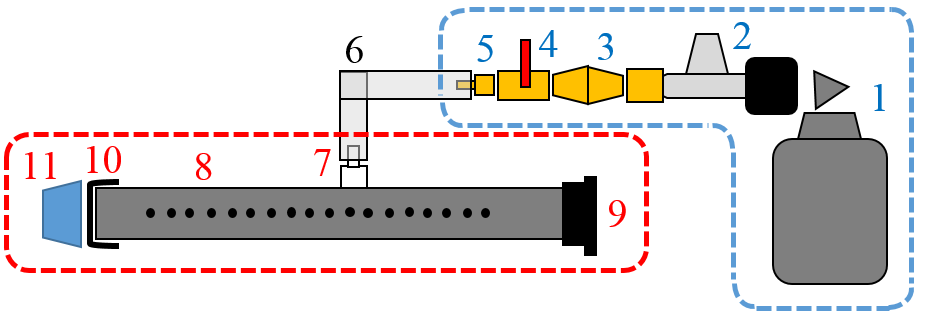Introduction
In this post, I’m going to take you step-by-step through the process of building your own Rubens Tube. The sections in the post are given below. You can click on them to skip to that particular section.
Overview and Schematic
Bill of Materials
How To Build It
– Tube Section
– Gas Section
– Finishing the Setup
Running the Tube
If you feel more comfortable watching a video on how to build the system, check out the video below.
Overview and Schematic
Below is a schematic of the setup. There are two dashed boxes, each of which represents a different section of the setup. I’ve broken it down into these sections because it will be easier to separate them for building purposes, and then connect them at the end with a flexible hose. The red boxed section is what I call the tube section, while the blue boxed section is what I call the gas section.
 Here’s a quick overview of how this works. We will get into the details in the next sections. The propane tank (1) holds the gas, to which a regulator (2) is attached to bring the pressure down to a usable, safe level. The regulator (at least the one I bought) has no method of adjusting the gas flow rate, so we need to install a valve (4) to give us some control. The valve has two female ends, so a nipple (3) is used to attach it to the regulator outlet. On the other side of the valve, we need a way to attach the hose (6), so we use a barbed fitting (5). The hose runs from the barbed fitting to another barbed fitting (7) that is inserted into the middle of the tube (8). The tube has holes drilled along its length, which is where the propane exits the tube. On one end of the tube, a solid flat cap (9) is attached. On the other end, a latex glove/balloon (10) is fit around the tube. A speaker (11) is placed close to the latex end, and music is played. Standing waves are set up in the tube, which changes the flow rate of the gases coming out of the tube through the holes. When the gas exiting through the holes are lit, flames are visible. When certain frequencies are played through the speaker, we can ‘see the sound waves’ in the varying flame heights.
Here’s a quick overview of how this works. We will get into the details in the next sections. The propane tank (1) holds the gas, to which a regulator (2) is attached to bring the pressure down to a usable, safe level. The regulator (at least the one I bought) has no method of adjusting the gas flow rate, so we need to install a valve (4) to give us some control. The valve has two female ends, so a nipple (3) is used to attach it to the regulator outlet. On the other side of the valve, we need a way to attach the hose (6), so we use a barbed fitting (5). The hose runs from the barbed fitting to another barbed fitting (7) that is inserted into the middle of the tube (8). The tube has holes drilled along its length, which is where the propane exits the tube. On one end of the tube, a solid flat cap (9) is attached. On the other end, a latex glove/balloon (10) is fit around the tube. A speaker (11) is placed close to the latex end, and music is played. Standing waves are set up in the tube, which changes the flow rate of the gases coming out of the tube through the holes. When the gas exiting through the holes are lit, flames are visible. When certain frequencies are played through the speaker, we can ‘see the sound waves’ in the varying flame heights.
